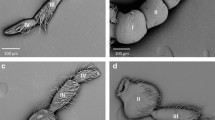Summary
On the antenna of adult male Periplaneta americana, three size ranges of classical sensilla basiconica were found. Based on SEM, a sensillum of the s. trichodeum shape was revealed, but our TEM efforts indicate that this sensillum has the thin-wall, porous ultrastructure of a sensillum basiconicum. Sensilla basiconica contain flask-shaped cuticular pores. All viewed pores join four or five tubules. The pore tubules clearly contact plasma membranes of dendritic branches. Two sizes of grooved pegs were observed. The terminal segment of the antenna contains a variety of other “receptors”.
Similar content being viewed by others
References
Baker, J. E., Norris, D. M.: Neurophysiological and biochemical effects of naphthoquinones on the central system of Periplaneta. J. Insect Physiol. 17, 2383–2394 (1971)
Baker, J. E., Norris, D. M.: Effects of feeding-inhibitory quinones on the nervous system of Periplaneta. Experientia (Basel) 28, 31–32 (1972)
Boeckh, J., Priesner, E., Schneider, D., Jacobson, M.: Olfactory receptor response to the cockroach sexual attractant. Science 141, 716–717 (1963)
Borg, T. K., Norris, D. M.: Ultrastructure of sensory receptors on the antennae of Scolytus multistriatus (Marsh.). Z. Zellforsch. 113, 13–28 (1971)
Bowers, W. S., Bodenstein, W. G.: Sex pheromone mimics of the American cockroach. Nature (Lond.) 232, 259–261 (1971)
Ferkovich, S. M., Norris, D. M.: Naphthoquinone inhibitors of Periplaneta americana and Scolytus multistriatus feeding: Ultra-violet difference spectra of reactions of juglone, menadione and 1,4-naphthoquinone with amino acids and the indicated mechanism of feeding inhibition. Chemico-Biol. Interactions 4, 23–30 (1971/72)
Ferkovich, S. M., Norris, D. M.: Antennal proteins involved in the neural mechanism of quinone inhibition of insect feeding. Experientia (Basel) 28, 978–979 (1972)
Hawke, S. D., Farley, R. D.: Antennal chemoreceptors of the desert burrowing cockroach, Arenivaga sp. Tissue & Cell 3, 649–664 (1971a)
Hawke, S. D., Farley, R. D.: The role of pore structures in the selective permeability of antennal sensilla of the desert burrowing cockroach, Arenivaga sp. Tissue & Cell 3, 665–674 (1971b)
Norris, D. M., Chu, H. M.: Chemosensory mechanism in Periplaneta americana: Electroantennogram comparisons of certain quinone feeding inhibitors. J. Insect Physiol., in press (1974)
Norris, D. M., Ferkovich, S. M., Baker, J. E., Rozental, J. M., Borg, T. K.: Energy transduction in quinone inhibition of insect feeding. J. Insect Physiol. 17, 85–97 (1971)
Norris, D. M., Ferkovich, S. M., Rozental, J. M., Baker, J. E. Borg, T. K.: Energy transduction: Inhibition of cockroach feeding by naphthoquinones. Science 170, 754–755 (1970)
Roth, L. M., Barth, R. H.: The sense organs employed by cockroaches in mating behavior. Behavior 28, 58–94 (1967)
Roth, L. M., Willis, E. R.: A study of cockroach behavior. Amer. Midl. Nat, 47, 66–129 (1952)
Rozental, J. M., Norris, D. M.: Interaction of a proteinaceous receptor and messenger naphthoquinones. Trans. Amer. Soc. Neurochem. 4, 116 (1973a)
Rozental, J. M., Norris, D. M.: Chemosensory mechanism in American cockroach olfaction and gustation. Nature (Lond.) 244, 370–371 (1973b)
Schafer, R.: An electrophysiological survey of antennal sense organs in the cockroach, Leucophaea maderae. Amer. Zool. 10, 224 (1970)
Schafer, R.: Antennal sense organs of the cockroach, Leucophaea maderae. J. Morph. 134, 91–104(1971)
Schneider, D.: Insect olfaction: deciphering system for chemical messages. Science 163, 1031–1037 (1969)
Schneider, D., Steinbrecht, R. A.: Checklist of insect olfactory sensilla. Symp. Zool. Soc. Lond. 23, 279–297 (1968)
Singer, G., Norris, D. M.: Comparative disc-electrophoretic study of different proteinaceous extracts from Periplaneta americana males. Comp. Biochem. Physiol. 46B, 43–56 (1973a)
Singer, G., Norris, D. M.: A disc-electrophoresis investigation of certain characteristics of Triton X-100 solubilized proteins from male Periplaneta americana. Experientia (Basel) 29, 1483 (1973b)
Slifer, E. H.: Sense organs on the antennal flagellum of a giant cockroach, Gromphadorhina portentosa, and a comparison with those of several other species. (Dictyoptera, Blattaria.) J. Morph. 126, 19–30 (1968)
Author information
Authors and Affiliations
Additional information
This research was supported by the Director of the Research Division, C.A.L.S., University of Wisconsin; in part by research grant No. GB-41868 from the U.S. National Science Foundation and by funds from Acme Chemical Company.
Rights and permissions
About this article
Cite this article
Norris, D.M., Chu, Hm. Morphology and ultrastructure of the antenna of male Periplaneta americana as related to chemoreception. Cell Tissue Res. 150, 1–9 (1974). https://doi.org/10.1007/BF00220376
Received:
Issue Date:
DOI: https://doi.org/10.1007/BF00220376



